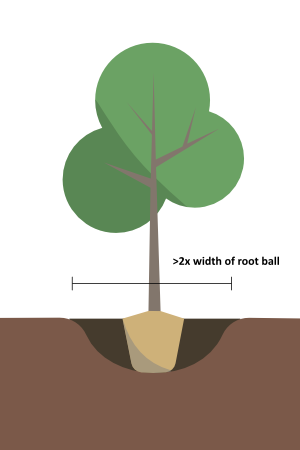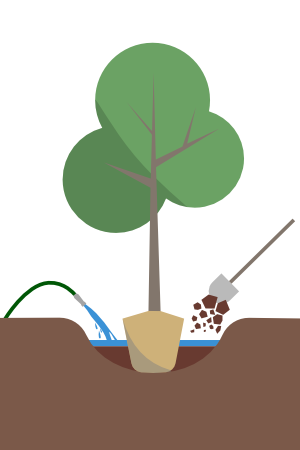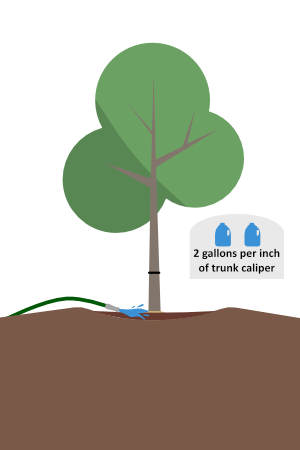Planting and Watering Instructions
Here goes your text … Select any part of your text to access the formatting toolbar.
Planting and Watering Instructions
en españolOn this page, Glover Nursery is here to guide you step-by-step through planting, watering, and caring for your trees, plus some pro tips to ensure they absorb water thoroughly.
If you have any questions about our planting and watering instructions, don’t hesitate to reach out through our General Inquiry Form. We respond quickly!
Note: All eligible plants and trees purchased from Glover Nursery must be planted and watered according to our guidelines for the 1-year warranty to remain valid. Please refer to our Warranty Policy page for more information.
Digging The Hole
Dig a wide, shallow hole the same depth and at least twice as wide as the root-ball.
Score or scratch the sides of the hole to enable the roots to penetrate the sides and grow into the existing soil.
Do Not Plant Too Deep
The root ball should rest on undisturbed soil to prevent settling too deep and covering the top of the root-ball after being planted.
If you dug too deep, pack the extra soil back quite firmly before placing the root-ball.
The first woody roots at the top of the soil ball should be just barely covered with soil.

Prepping The Plant/Root Ball
- Saturate the root-ball while it is still in container.
- Remove root-ball from the container. Do not handle the plant by the trunk. Lift the tree/shrub by root-ball or use the wire basket.
- Do not bounce, crack, or break the root-ball.
- EASE the root-ball into the hole gently so as not to break the soil around the roots.
- Balled and Burlapped (B&B) trees need to be:
- Centered in the hole
- Twine cut and removed
- Burlap cut halfway down from the top of the root-ball and removed.
- Wire baskets should be cut with hacksaw or bolt cutters halfway down or bent back so no wire sticks up above soil level. You may leave the bottom of the wire basket on the root ball.
- Remove any string or tags tied around the trunk or branches.

If Using MYKE Mycorrhizal:
- For planting and watering instructions, including MYKE products, spread the calculated amount of MYKE directly onto the root-ball. DO NOT BREAK THE ROOT-BALL.
- Patting it (rather than shaking it from the container) onto the root-ball will make it stick more effectively.
- The MYKE product must come in direct contact with the roots or the outer surface of the root-ball.
- Plants in fiber pots that are not fully rooted in may be left in the pot:
- Trim the rim of the fiber pot off below the soil level.
- Mix some MYKE around the inside edge of the fiber pot.
- Place the rest of the MYKE in the soil immediately next to the outside of the pot.
Backfilling Hole & Settling Soil
- Place a garden hose at the bottom of the hole next to the root-ball (turn the water on in step 6.)
- Backfill hole with the recommended soil mix.
- Apply water and the Root Starter mixture to completely saturate the root ball and the soil mix.
- Soil should slope gently away from the trunk with the very top of the root-ball slightly visible after planting.
- Build up a rim of soil at the edge of the root-ball to direct water to the roots.
- The rim of soil should be raked away after one year.
- Turn the hose on a gentle flow and allow the water to bubble up to the surface until the soil is saturated, then remove the hose from the hole.
Loose, chunky mulch, such as bark, may be placed around the plant. Do not allow any of the mulch to touch the trunk or to bury any of the lower branches.

Recommended Soil Amendments
- CLAY SOIL needs help with drainage and preventing soil compaction. We recommend any of the following soil amendments:
- Soil Building Conditioner
- Soil Pep
- Nutrimulch
- Organic Compost
- Garden Mix
- SANDY SOIL needs help with moisture retention. We recommend blends containing peat moss such as:
-
- Planting Mix
- Rich & Complete
- Both types of soil will benefit from adding Acid Planting Mix due to the alkaline nature of our soils in Utah.
Soil Mix For Planting
- Mix the appropriate amendment for your soil type with the soil that was removed from the hole.
- Ratio of mix for backfilling the hole should be approximately 20-30% amendment to 70-80% existing soil.
-
Watering Instructions for Newly Planted Trees (First 3 Months)
- Sprinkler water is not enough for newly installed trees and shrubs.
- We highly recommend hand watering new trees and shrubs through the first two growing seasons for the proper establishment of the root system.
- Deep soak by turning on a hose to a slow trickle and place the nozzle within the basin until the soil is completely saturated. Soak time will vary according to the size of the root-ball.
- Two (2) gallons of water per inch of trunk caliper are required for each watering.
- All new plants require deep soaking 2-3 times per week (depending on weather and temperature) for the first three months.

Second Growing Season
Deep soak trees and shrubs twice monthly, in addition to sprinkler watering.
Plants grown in clay soil need less frequent watering than those in sandy soil.
Important Winter Watering
- Monthly deep soaking of trees and shrubs during winter is necessary unless there is frequent snow or rain.
- Deep soak all trees and shrubs just prior to the onset of winter, around Thanksgiving. Then, water once per month through the winter season.
- Use National Holidays as an easy way to remember when to water.
Glover Pro Tips:
Deep Soaking
- Get a 5 gallon bucket and drill a small hole in the bottom center (use a 1/8″ bit). Place the bucket close to the tree, fill with water and leave it until the water drains out. The small hole means the water won’t leak out too fast while ensuring those roots get the deep moisture they need.
- For smaller trees/shrubs, use 2-3 times per week during the first growing season. 1-2 times per week for the second growing season.
- For larger trees, fill two buckets 2-3 times per week during the first growing season (or, fill the same bucket 2 times, just move it to the other side of the tree for the second time). 1-2 times per week for the second growing season.
Winter Watering
- This should be done from October through March. Use National Holiday dates as an easy way to remember when your next date for soaking should happen.
- Here are a few ways to make this an easy chore:
- Place approximately 32 oz. of ice around the root-ball once a month (twice a month for larger trees) to ensure the soil has enough moisture for the root system during the winter months.
- Use a 5 gallon bucket method described above.
- If the weather is nice, pull the hose out of storage and let it run over the root ball area on a slow trickle (so it gently absorbs into your soil instead of running off from high water flow pressure).
Glover Nursery does not recommend staking a tree unless placed where severe winds affect the ability of the tree to stand upright.
- Staking deters the ability for the roots to properly develop and support the tree.
- In the case that staking is needed, the stake should be placed into the wind, and loosely tied around the trunk.
- The trunk must have some ability to move or it will be damaged or even break.
These are just a few of the best practices to get you started. For more in-depth planting and watering instructions, we invite you to visit the store and speak with one of our master gardeners.
If you’re looking for more helpful resources, check out our seasonal plant tips page by clicking the button below to ensure year-round care for your plants, shrubs, and trees.